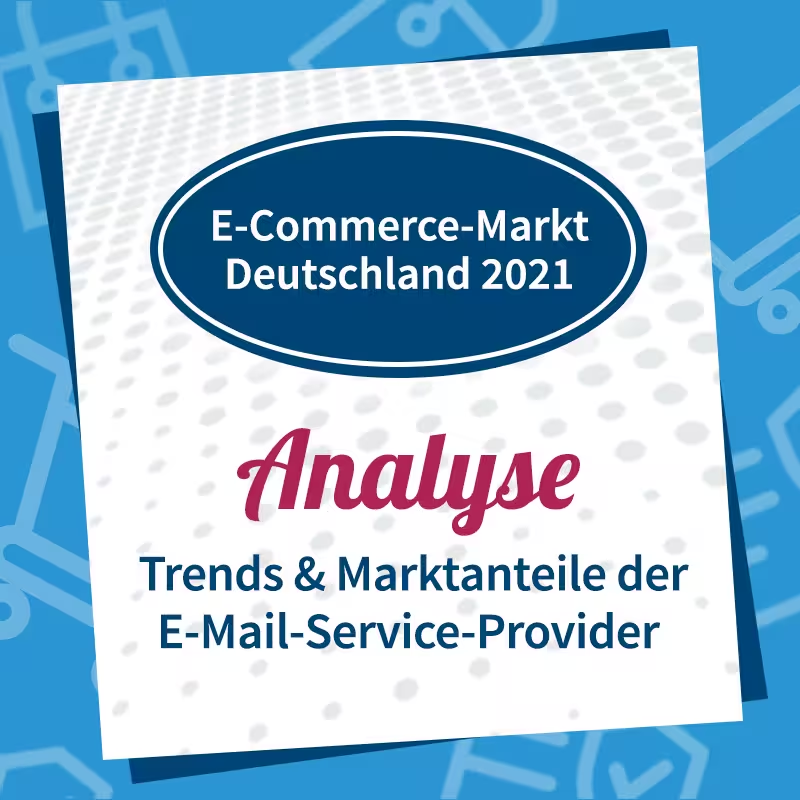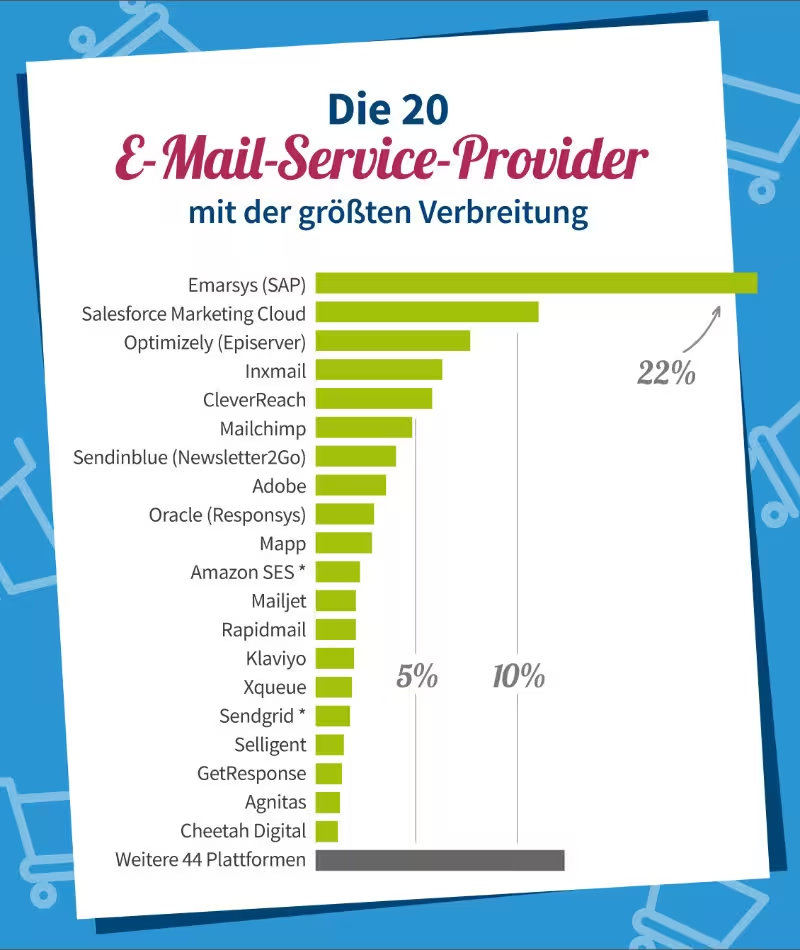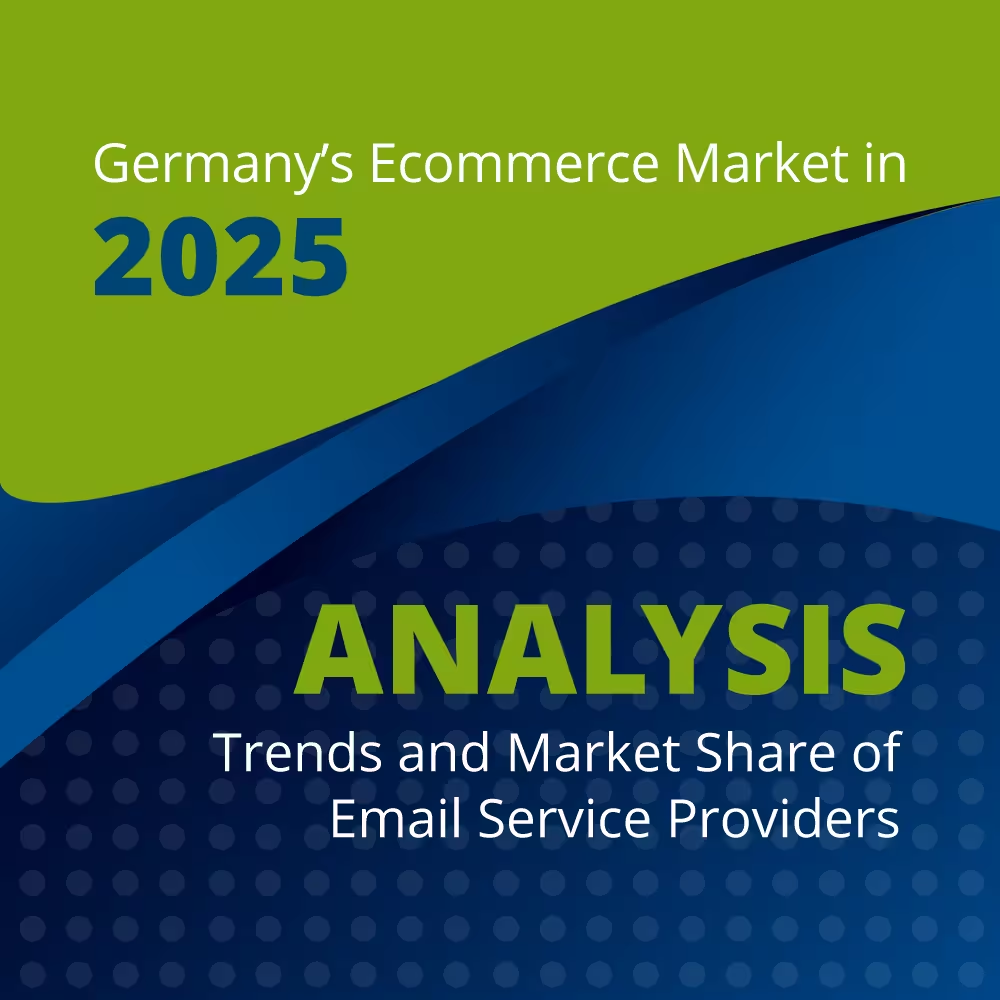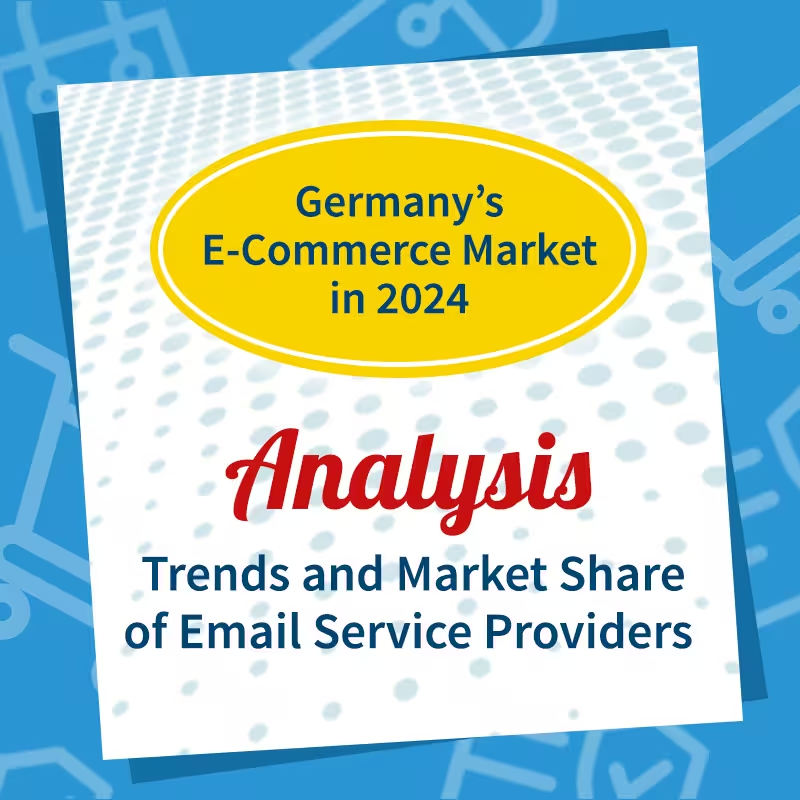The email marketing of Germany's 1,000 top-selling online shops 2021
87 percent of the thousand top-selling online shops in Germany are actively engaged in email marketing1. We have now investigated for the fourth time which tools shops use for this purpose as part of “German e-commerce market 2021” study by EHI Retail Institute and Statista. To do this, we have once again subscribed to newsletters from all providers, provided that no purchase was required to register.
We received over 70,000 emails during the investigation period. Around two thirds (68%) of the 871 active online shops emailed us at least weekly, 19 shops even every day. Only 129 companies did not send us anything because they either do not have a newsletter subscription (73) or have one but did not send us any emails apart from the registration confirmation (56 companies after all). These figures are barely changed compared to 2020, which shows that email is still an extremely popular marketing tool.

Here you can find the latest analysis results for Email marketing from the top 1000 e-commerce companies in Germany 2024
Market shares of email service providers in the EHI Top 1,000 e-commerce
To identify the email systems used for sending, we searched the headers of the newsletters sent for features that uniquely identify the sender. Where no professional systems could be identified, either in-house developments or the shipping solutions integrated into the shop system are used. However, this is rarely the case: Over 95 percent of the 871 shops that send newsletters use an ESP2 (email service provider) or a sending service. In 2021, we no longer have a distinction between ESPs and “sending services,” i.e. solutions that are connected directly to the shop or other (in-house) marketing systems via interfaces (APIs) — as a result, Sendgrid and Amazon SES are new to the list. The boundaries in classifying these systems are becoming increasingly blurred, as some sending service providers such as Sendgrid also offer both, i.e. both a marketing automation front end for business customers and a sending service backend for email marketing providers. In contrast, only 13 (1.5%) use a shop's own script or module; a further 28 (3.2%) had no discernible shipping system. In the previous year, the share of these two groups was significantly higher, totalling 6.2 percent. This shows that more and more online shops rely on email service providers when it comes to topics such as mail server configuration, shipping control or email deliverability.
Confusing, fragmented and unevenly distributed
There is no market consolidation in sight in 2021 either: The top 1000 top-selling online shops in Germany — more precisely: the 830 identified online shops — use 64 different email delivery systems for their email marketing. This once again shows the picture of a highly fragmented market, as we have already shown in the last three years. After all, for the first time, the total number of systems fell (in 2020, we identified 71 ESPs and sending services, compared to 70 in 2019).3
In principle, the unequal distribution of solutions is also unchanged: The 20 most-used platforms have a market share of 87.6 percent, the two leading providers Emarsys (acquired by SAP in 2020) and salesforce serve around a third of the market alone. However, no other provider reaches the 10 percent market share threshold.
Outside of the 20 most common solutions, the number of users quickly becomes marginal: For BloomReach In 21st place, whose platform emerged from the acquisition of Exponea in January 2021, we were able to identify 7 shops, for Artegic In 25th place, there were 5 shops — here, the profit or loss of a customer leads to big leaps, but in an area with a market share of well below 1 percent.
30 platforms are only used by one or two of the 1,000 top-selling German online shops.
The market is moving — if you look long enough
A look at market shares shows that, as in previous years, Emarsys Marketing Platform is clearly the most used solution. 183 of the 830 identified shops (22%) use the solution acquired by SAP in 2020, almost exactly twice as many as Salesforce Marketing Cloud (92 shops, 11%). Salesforce is now represented at 9 stores more than in 2020, one of the biggest increases in our list — the multi-cloud solution provider is thus continuing its growth in recent years (2020:83 shops; 2019:62 shops; 2018:41 shops). This shows that there is movement in the market — but you don't change an email service platform every year, so trends only become apparent over longer periods of time.
The third-placed Optimizely (formerly Episerver, previously Optivo) is also continuing a trend, but in the other direction: Only 64 of the top 1000 online shops still use the solution — Episerver was still used by 77 e-commerce companies in 2020, which already meant one of the biggest absolute losses compared to 2019, when 84 online shops were still using the solution.
Mailchimp is also losing quite significantly and is only used by 40 shops from our population instead of the previous 48 — has the assessment of the Bavarian State Office for Data Protection Supervision had an effect here? In any case, the US company's market share has been falling slowly but steadily since we carried out this study for the first time in 2018, from 6.6 to 4.8 percent now. This may show that Mailchimp has less functionality to offer than competitors in the increasingly important areas of segmentation and automation, or that many functions are only included in the premium package. We also see a similarly slow but steady downward trend in Mapp or Cheetah, for example. The market share of German email marketing platforms, which focus primarily on the email channel (such as CleverReach, Inxmail or XQueue), remains relatively stable with minor fluctuations.
A clear winner, on the other hand, is Klaviyo, which, with 10 stores more than in 2020, has the largest recorded growth of all — even though the US Americans still have a total market share of just under 2 percent and (still?) Not growing as massively as in their home market. It will be interesting whether lean marketing automation platforms will continue to grow in Germany, such as Klaviyo or GetResponse (from 4 shops in 2020 to 11 shops 2021), which, in addition to email automation, also enable the creation of landing pages, social advertising or SMS and offer turnkey integrations with many shop systems.
The background senders: Sendgrid, Sparkpost, Amazon SES, and Mailgun
One trend that has already been apparent in recent years is the growth in sending services: developer-oriented sending platforms that take over email delivery — either by being addressed directly from the website/shop via API or by acting as a backend sending machine for another email service provider. In addition to the 37 online shops (4.5%) where we can identify a sending service, 32 of the top 1,000 online shops (3.8%) use a marketing platform in the “front end”, which sends in the background via a sending service. For example, SAP Marketing Cloud uses Amazon SES to send emails; Braze and Klaviyo send emails via Sendgrid; SparkPost is addressed by Ometria and Iterable, for example, and BloomReach (Exponea) sends emails via Mailgun, among others.3
In our market share overview above, we have listed the email marketing providers in the “front end” that are used by e-commerce companies. But if you only look at the actual email senders, the distribution changes: Klaviyo disappears from the top 20 again, but Mailgun moves up. Sendgrid and Sendinblue are moving up to 7th and 9th places among the most used email delivery tools in e-commerce.
In our analysis of the Most popular email marketing tools of the top 1,000 US online stores 2021 It was shown that Sendgrid, with a market share of just under 20%, is now number 1 of the most used shipping service provider in American e-commerce.
The trend has two effects: On the one hand, sending services benefit from economies of scale — the more a service is used, the sooner it can offer low prices per sent email (CPM). In addition, the market continues to open up: Email service providers who process shipping via sending services can offer a campaign front end without worrying about the time-consuming and complex issue of deliverability. Especially for multichannel platforms, for which email is just one of many channels, this requires less investment and know-how.
Will our development be similar to that in the USA? Last year, the rate of German shops with sending services was 3.4 percent, this year it amounts to 8.3 percent. We are continuing to monitor developments.
The market shares of 64 email service providers among the EHI top 1,000 e-commerce companies in Germany3
On request, we would be happy to share with you the complete overview and 5-year trend of the market shares of the email marketing shipping solutions used in German e-commerce in 2021. We conduct this study every year, so please also read our latest study for an up-to-date market overview of current market shares. If you are interested in more information about the 2021 data, we recommend the detailed study by EHI/Statista.
Method and population
1 Basis: The 1,000 best-selling B2C online shops and selected marketplaces in 2021, determined by EHI Retail Institute “E-Commerce Market Germany 2021", sorted by e-commerce sales in fiscal year 2020.
2 Online stores that sent at least one marketing email in the 12-month investigation period in percent. n = 871.
3 Online shops that sent emails via a shipping platform identified as an ESP or sending service during the 12-month investigation period. The percentage market share is calculated from the number of companies for which the respective sender was identifiable. n = 830.
* excluding companies that use this sending service as backend senders of marketing automation — in this case, the “front-end” tool was included in this list (if the respective ESP was identifiable).














